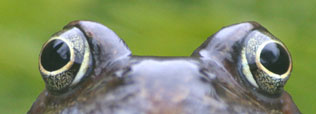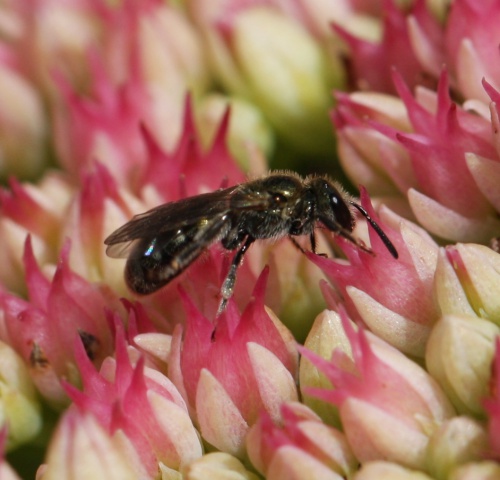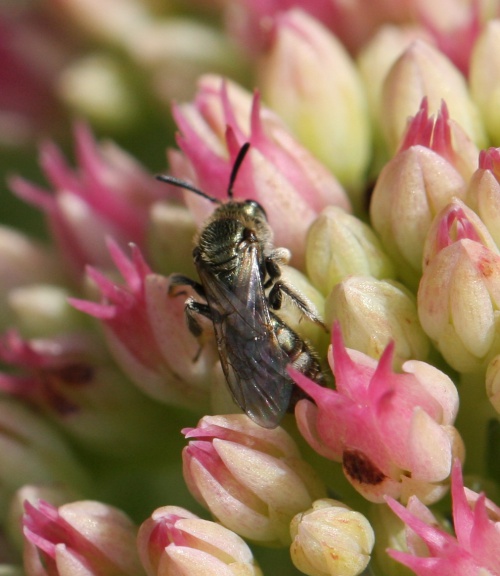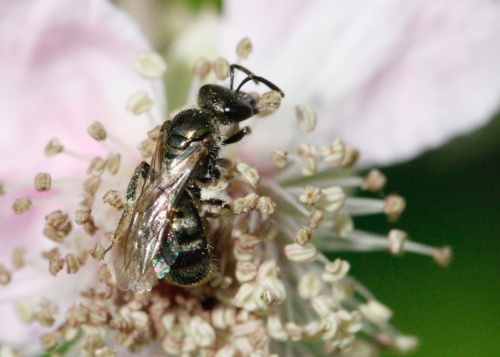Smeathman's Furrow-bee - Lasioglossum smeathmanellum
One of four metallic green Lasioglossum bees in Britain. This species has a rather blue-green sheen over both the thorax and abdomen which can often be discerned in the field. Although these features often serve to distinguish it from the similarly green L. morio and L. leucopus, separation from the closely related, but more northerly and westerly distributed, L. cupromicans requires considerable care and microscopic examination. L. smeathmanellum has a scutum with sparse punctures of different sizes and a propodeum that has a rugose (wrinkled) texture.
L. cupromicans has a smooth and shiny propodeum.
- wing length 4-4.5mm
- metallic green head, thorax and abdomen
- sparse and uneven punctures on the scutellum
- rugose propodeum
Most solitary bees and wasps are difficult to identify, and can rarely be identified from photos taken in the field. All red-rated records should include a photo or set of photos of the specimen, illustrating the key characters taken from a standard key, which should also be referenced (e.g. ‘Falk, 2015’). The full set of key characters are generally not visible in field photos and photos are rarely sharp enough. To aid in the verification of your records, please include face shot, side, top and wings. The notes should state whether male or female, and explain how the specimen met the key characters. Although NS may not be able to identify the species even if these reference photos are provided, the photos will be stored with the record and may allow it be identified in future. Alternatively, NS will accept records identified by a recognised local or national expert, or that have been identified via BWARS’ Facebook https://www.facebook.com/profile.php?id=100065021433202 . If you have obtained this advice, please note the name of the person/organisation identifying the record in the ‘determiner’ field (e.g. ‘Stuart Roberts, BWARS Facebook’) rather than just a comment of ‘BWARS Facebook’.
Favours habitats such as soft-rock cliffs and brownfield sites
Females fly between late March and September, males are found between July and September.
As with all British Lasioglossum, only mated females hibernate. Many types of flower are visited but especially composites.
This is a widespread and locally common species from southern England, and Wales north to Northumberland. It is gradually replaced by the closely related Lasioglossum cupromicans towards the north, and in upland situations, particularly in the South-west.
Fairly frequent in Leicestershire and Rutland.
Leicestershire & Rutland Map
Enter a town or village to see local records
MAP KEY:
Yellow squares = NBN records (all known data)
Coloured circles = NatureSpot records: 2020+ | 2015-2019 | pre-2015
UK Map
Species profile
- Common names
- Smeathman's Furrow Bee
- Species group:
- Bees, Wasps, Ants
- Kingdom:
- Animalia
- Order:
- Hymenoptera
- Family:
- Halictidae
- Records on NatureSpot:
- 5
- First record:
- 01/05/2015 (Helen Ikin;Steve Woodward)
- Last record:
- 29/07/2021 (Nicholls, David)
Total records by month
% of records within its species group
10km squares with records
The latest images and records displayed below include those awaiting verification checks so we cannot guarantee that every identification is correct. Once accepted, the record displays a green tick.
In the Latest Records section, click on the header to sort A-Z, and again to sort Z-A. Use the header boxes to filter the list.





